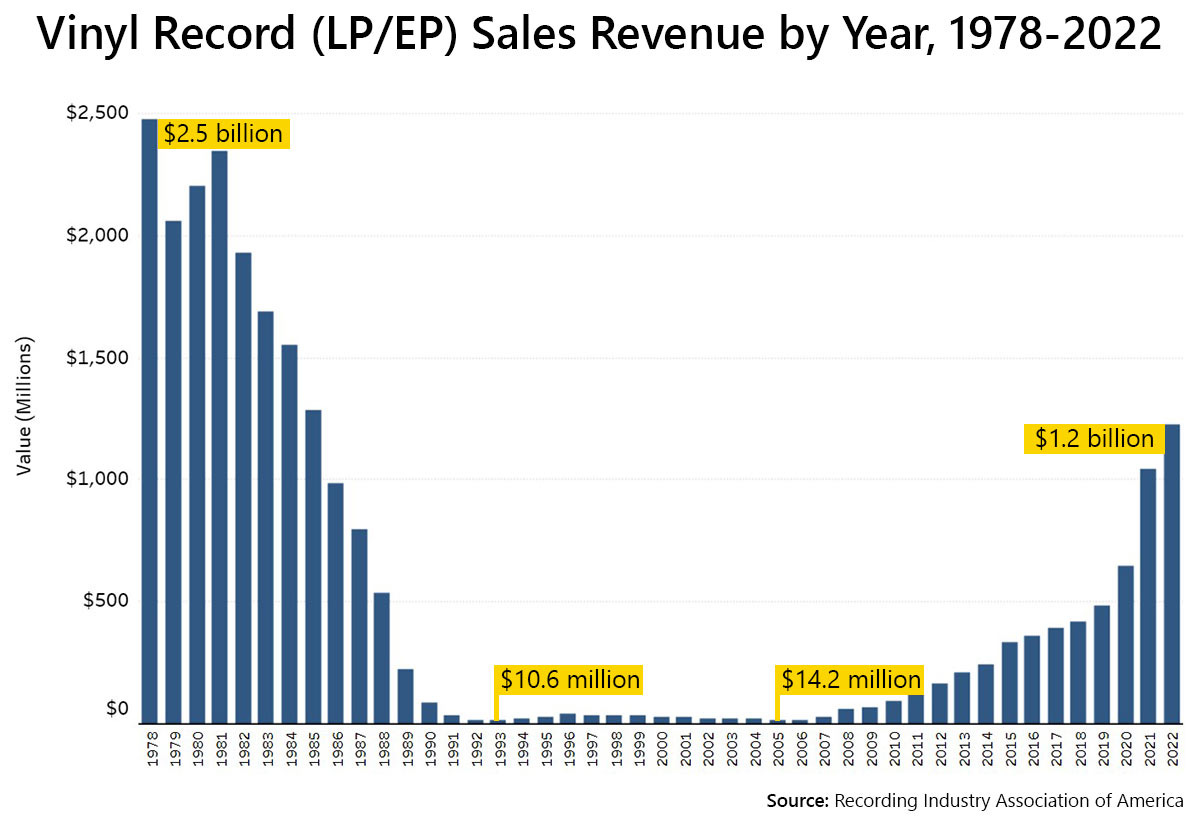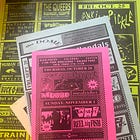Reviving Retro: Why Tangible Media is Shaking Up the Digital Age
As the internet begins to feel soulless, there is yearning for the analog revolution

I want to be part of the resurgence of things that are tangible, beautiful and soulful, rather than just give in to the digital age. But when I talk to people about this they just say, 'Yeah, I know what you mean,' and stare at their mobiles. - Jack White
Due to the wind and fires, my power has been going out in Southern California several times a week. It's frustrating, but it has forced me to recognize how reliant I have become on the digital world and digital media. Lately, I have enjoyed reading a tangible book instead of doomscrolling online.
In the same way, Facebook and Instagram primarily consist of viral AI videos and ads. I don’t know about you, but the digital experience these days seems tainted and full of slop. It is inauthentic, and a fellow Substack writer, J.P. Hill, used the word “enshittified.”
What Is The Dead Internet Theory?
The barrage of meaningless information reminds me of the Dead Internet Theory, which states that bots and AI-generated content have replaced the vast majority of internet traffic, posts, and users and that actual people no longer shape the direction of the internet.
The internet can feel "soulless" because of a combination of factors, including the lack of genuine human interaction, the prevalence of curated online personas, excessive advertising, repetitive content, and the absence of physical presence. These factors can lead to disconnection and superficiality in online relationships and experiences.
Psychology Today, in an article from January 2025, says,
Dead Internet Theory may be hyperbole, but it raises two important points. First, the internet is undeniably moving in this direction. Meta, for instance, has announced plans to create AI users to populate its social networks. Second, and more significantly, the theory taps into a broader unease about online emotional and social dynamics.
The theory touches on a real and profound issue: the growing concern, malaise, and disillusionment with how automation and algorithms dominate online spaces. Many users report a hollow, uncanny feeling during online interactions, like shouting into a crowded void and only hearing echoes.
Let’s contrast this with something more authentic, more tangible. In a world obsessed with the virtual, tangible things are once again making history. Tangible Things invites readers to look closely at the things around them, ordinary things like the food on their plate and extraordinary things like the transit of planets across the sky. It argues that, when examined closely, any material thing can link the present and the past. It is the small things and the tangible things that I am craving at this present moment in time. Let’s talk about the authenticity of tangible media.
Tangible media engages more senses. Engaging additional senses adds depth and texture to each media type, enhancing our senses. For example, holding a physical object allows for a multi-sensory experience, including touch, sight, and sometimes even smell, strengthening the connection to the content. Tangible media has a significant factor of nostalgia built into it. For many, physical media can evoke positive memories from their childhood or past, leading to a desire to revisit that feeling.
Tangible Media has collectible value. Certain physical media items, like limited edition vinyl records or signed books, can have added value as collectibles. Connecting with loved ones through shared interests is a significant appeal regarding physical media. Whether someone has been collecting for decades or just a few months, you can always find common ground. Maybe it’s just sharing a bond of collecting records, or you are interested in similar genres and artists.
Additionally, some people find that interacting with physical media can promote more focused attention compared to the constant distractions of the digital world. For some reason, I can read a tangible book printed on paper and retain that information better than a digital one.
Examples of tangible media resurgence
Vinyl Records
Vinyl sales have significantly risen in the past decade, with people actively seeking turntables to play their record collections. The Conversation explains that the return of vinyl is a global media comeback story. It is so significant that the BBC recently reported that after a 30-year absence, Britain’s Office of National Statistics has placed vinyl records back into the basket of goods, which is used for tracking consumer pricing and measuring inflation.
One reason for the resurgence of vinyl is Record Store Day. Record Store Day was launched in 2008 to celebrate and promote the unique culture of independent record stores in the US. As part of the annual event, limited numbers of special vinyl and CD releases are available exclusively at participating record stores. The event was so successful that it is likely the primary cause of the 147% increase in total US vinyl record sales that year. The event has expanded significantly since 2008, and although it has faced some criticism over the years, it remains a significant driver of the new vinyl renaissance.
The return of vinyl appeals to nostalgia, helping folks remember simpler times. Additionally, vinyl records are collectible, adding to the thrill of finding rarities and making it an eventful and fun hobby.
Vinyl also appeals to various senses, from the smell of the records to the artwork on the album covers to the warmth of the crackling and popping sounds of the rich recorded tones. All of this adds to the pleasurable experience of engaging more senses.
Independent record stores flourish because of the sensory appeal and community aspect of listening to records. They are a fun and engaging third space where DJs spin, and folks hang out, listen together, and maybe even dance. I remember the excitement of going to the music store when I was younger to shop and listen at listening stations, and being around other people for album release events was something to look forward to. Listening to records is a highly social and cultural practice connecting past to present and locates individuals within real and imagined communities.
Physical photography
When did you last look at all the photos you took in your phone's photo gallery? There is something to be said for the joy of printing and displaying images in albums or frames instead of just storing them digitally.
One thing that stood out to me was the great pleasure of working in a dark room amongst other people and the sensory experience accompanying the actual development of one’s photos in a photography class in college.

According to Fotorumor,
What began as a nostalgic hobby for a few enthusiasts is now gaining momentum, and by 2025, the resurgence of film—or analog photography—is expected to take off like it did in its golden era. This revival is not just about reliving the past; it's about reclaiming the authenticity and artistry that many feel has been lost in the wake of digital domination and the growing influence of AI on the photographic world.
There is a tactile component to using film that includes the sound of the clicking shutter and the advancing of the film, and even the anticipation of waiting for the development of the film, which are things that digital photography can never replace.
Film photography is a return to its analog roots, embracing the medium as a form of rebellion against the oversaturation of digital and AI imagery. This slower and more intentional process requires patience, understanding, and skill, and it doesn’t have the instant gratification that digital photography does. The result is not just a photograph but a work of art carefully crafted from when the camera's shutter clicks to when the film is developed.
Shutter Junkies magazine explains the component of richness in tangible photographs,
Film’s aesthetic qualities are also a significant draw. The natural grain, rich colors, and wide dynamic range of film create images with a distinct look and feel. These characteristics are often described as having more “soul” or “character” compared to the clinical precision of digital images.
Learning to shoot with film can be an invaluable educational experience for photographers. It teaches the fundamentals of exposure, composition, and light in a way often lost in the digital realm. For many, mastering film is a rite of passage that enhances their overall photography skills.
Also, there is the community aspect of photography. The growing film photography community is vibrant and supportive. From online forums to local meetups, film photographers enjoy sharing their knowledge, experiences, and passion. This sense of community inspires more people to pick up film cameras and join the analog movement.
Books and Independent Bookstores
There is a resurging appreciation for browsing physical bookshelves and supporting local bookstores.

Howard Tullman from Inc. Magazine explains,
I’ve insisted for many years that nothing would ever replace the sheer visceral joy of browsing a bookstore, the delight of happening upon new discoveries, and the efficiency of visually scanning dozens of stacks and shelves looking for new titles and those by familiar authors. One of the last great creative arts in advertising and marketing is the design and beauty of striking, surprising, and stirring book covers. Digital displays of any size filled with stamp-sized jpegs, tiny gifs, and banner ads can’t compete.
Nothing is better than the smell of the ink on the pages or the smell of the paper itself within a book. Additionally, I get much more joy from turning the pages and reading a tangible book than I ever had a Kindle book. Also, let’s not forget the joy of simply being in a space surrounded by so many books and words. I love bookstores and libraries and the community space of learning they represent.
Ironically, BookTok has been at the forefront of creating this bookstore phenomenon. CNN explains, “Many stores took advantage of the heyday of BookTok and created tables and specific displays of varying sizes because they had that flexibility, which is another beautiful thing about the stores determining their destiny.”
Barnes & Noble has also tapped into BookTok’s fandom by hosting community events, from midnight release parties to costume competitions. Again, this is the community / third-space aspect of things that appeals to people as a social aspect of the bookstore.
In a world where everything is digital, print media offers a refreshing break from the screen. The paper's weight, the ink's smell, the sound of turning pages—an immersive experience that can't be replicated online.
The renaissance of tangible media clearly shows the relationship between our past and present. It highlights a yearning for tangible and authentic experiences and a break from the omnipresence of digital technology. It also reminds us that in our fast-paced, digitally-driven world, there is still room for the slow and the deliberate.
Related stories:
Rediscovering Slow Journalism
I remember a conversation I had with a communication studies student in 2006 about the creation of Twitter. At that point in our lives and the technology timeline, we could not fathom why folks would want to use it and share so much about what they were doing minute to minute. We laughed at how ridiculous it sounded to pos…







I love brushing the dust off the vinyl, wiping it with that special microfiber cloth, blowing it, placing it on the disc and dropping that needle...pure bliss! 🌞🌞🌞
Great piece!
This is such a fraught moment in history. The media of it all, but also the veering-toward-apocalypse weather events.
I guess you could also bring up live music (altho to some extent that was covered in your last post). And one of the 3 is a public (third, or community) space — live music would be that, as well.
But I am finding it sad that there are only 3 (maybe 4) types of tangible media.
And as you note, these are older kinds of tech and bring with them nostalgia for older folks.
Are we going backward? Is that what’s needed?